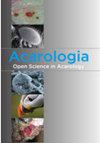Uropodella(Acari:中柱目:Sejidae),从始新世到全新世没有变化的螨虫
IF 1.1
3区 农林科学
Q3 ENTOMOLOGY
引用次数: 0
摘要
第一个记录是来自波罗的海琥珀的sejoid属Uropodella(Uropodellidae科,Sejida亚目),以一只保存完好的成年雄性为基础。从形态学上看,该标本的结构与现存六种已知的尾足目动物的成虫一样现代。根据对化石与现存物种的区别诊断,有理由将其命名为一个新物种。这一记录将该属追溯到始新世,代表了中柱属最古老的确认年龄。文中给出了尾足菌属的一个种的索引。本文章由计算机程序翻译,如有差异,请以英文原文为准。
Uropodella (Acari: Mesostigmata: Sejidae), mites unchanged from Eocene past to Holocene present
The first record is presented of the sejoid genus Uropodella (family Uropodellidae, suborder Sejida) from Baltic amber, based on a well-preserved adult male. Morphologically, the specimen is as modern in structure as adults of the six known extant species of Uropodella. The diagnosis of the fossil in distinction to the extant species justifies naming it as a new species. This record traces the genus back to the Eocene, representing the oldest validated age for a mesostigmatan genus. A key to species of the genus Uropodella is given.
求助全文
通过发布文献求助,成功后即可免费获取论文全文。
去求助
来源期刊

Acarologia
ENTOMOLOGY-
CiteScore
2.00
自引率
18.20%
发文量
81
期刊介绍:
Acarologia is a free open-access journal. Please help us by submitting manuscripts in accordance with following instructions.
All manuscripts which do not conform to the instructions will be returned to authors without the benefit of review.
Acarologia publishes the results of original research on all aspects of Acarology.
The journal policy is that taxonomic descriptions should include several species within a same genus/family, when possible.
The editors reserve the right to refuse manuscripts when authors intentionally divide individual species descriptions of the same genus/family into distinct publications.
Single species descriptions should be clearly justified based on their scientific interest.
 求助内容:
求助内容: 应助结果提醒方式:
应助结果提醒方式:


